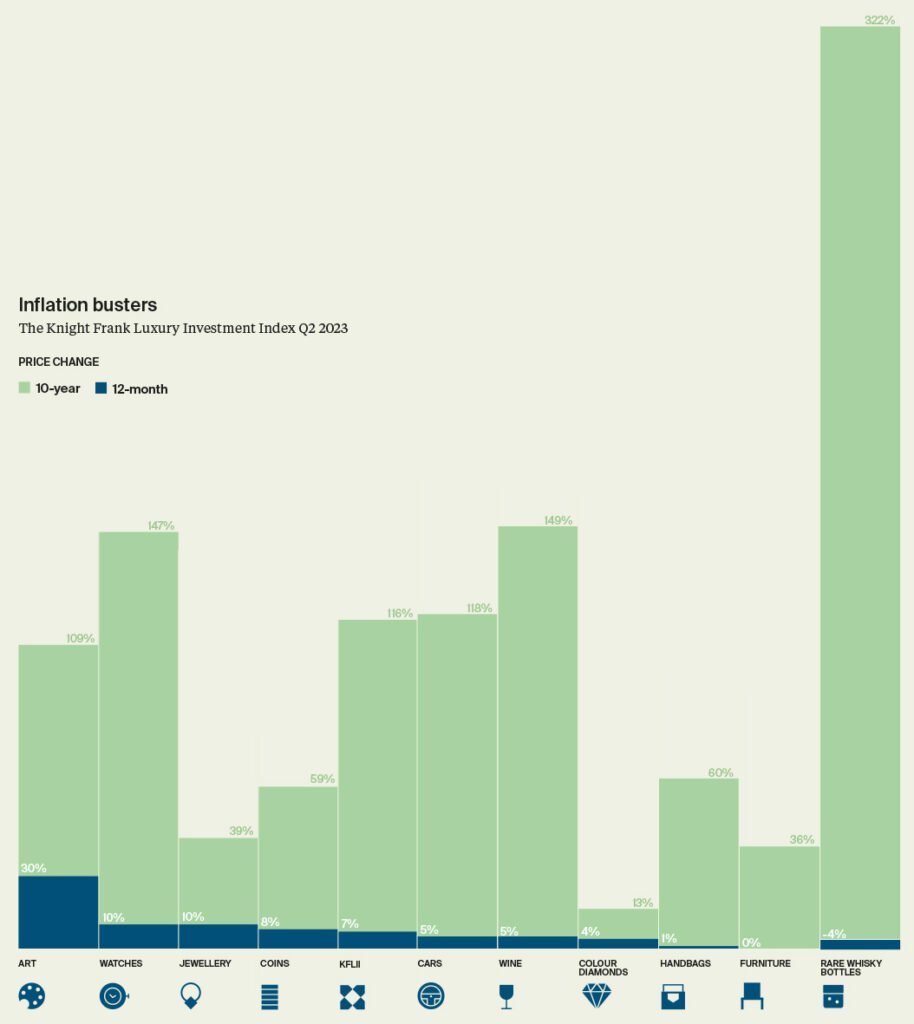In the world of high finance, where numbers dance across screens and algorithms dictate trades, a different kind of investment holds sway: luxury collectibles.
According to Knight Frank’s 2024 The Wealth Report, individuals with substantial wealth—those exceeding $US30 million (approximately $45 million)—typically allocate 20% of their portfolios to luxury items. These include art, watches, classic cars, wine, and jewellery, coveted not just for their financial potential but also for the sheer joy of ownership they offer.

The global luxury market, valued at approximately €1.5 trillion in 2023, continues to expand, driven by discerning buyers and a growing appetite for exclusivity and quality. While luxury goods have always held allure, it was Bernard Arnault’s visionary merger of Louis Vuitton and Moët Hennessy in the 1980s that catapulted them into the realm of serious investment. This strategic move birthed LVMH, Europe’s most valuable company, and set a precedent for integrating luxury with financial acumen.
Thus, it is no surprise that luxury goods have since carved out a niche as tangible assets that appreciate over time, making them attractive investments. In fact, recently, a rare 1962 Ferrari 330 LM/250 GTO set a new benchmark at an RM Sotheby’s auction in New York, fetching a staggering US $51.7 million (AU $78.6 million) including fees. This record-breaking sale underscores the robust market for luxury collectibles, where items like a bottle of whisky selling for US $ 2.7 million (AU $4 million) or a coloured diamond for $US34.8 million ($53 million) are not anomalies but reflections of sustained demand and appreciation.
Diverse Categories, Singular Appeal
Luxury goods span diverse categories, each with its own allure and investment potential. High-end fashion and accessories, for example, encompass designer clothing, handbags, shoes, and accessories from venerable houses like Louis Vuitton, Prada and Gucci. These brands not only command loyalty for their heritage and craftsmanship but also attract collectors who view their pieces as both art and investment.
Luxury automobiles, such as Porsche, Bentley, and Rolls-Royce, embody prestige, technological innovation, and meticulous craftsmanship. Beyond their hefty price tags, these vehicles offer investors a stable market driven by brand reputation and evolving consumer preferences.
Fine jewellery and watches from names like Rolex, Tiffany & Co., and Cartier, epitomise meticulous artistry, timeless design, and the use of precious materials. Their value often appreciates with time, reflecting not just economic trends but also the enduring appeal of heirloom-quality pieces.
Fine wines and spirits, including prestigious labels from Moët Hennessy and Remy Cointreau, thrive on global demand and a penchant for premiumisation. As emerging markets embrace luxury consumption, these beverages offer investors both cultural cachet and financial returns.
High-end cosmetics and fragrances by Dior and Estée Lauder, while comparatively accessible in price, boast high-profit margins and brand loyalty. The sector benefits from evolving beauty trends and the influence of social media, shaping consumer preferences and investment opportunities alike.
As such, luxury goods can present a compelling investment case. Investing in luxury would be driven by the following factors:
Value Appreciation: Iconic pieces from renowned brands often increase in value over time, driven by scarcity and desirability among collectors. Limited editions and discontinued models fetch premium prices in secondary markets, offering substantial returns on investment.
Craftsmanship and Quality: Luxury items are synonymous with exceptional quality and meticulous craftsmanship. Brands like Louis Vuitton and Ferrari uphold stringent standards, ensuring durability and prestige that translate into enduring value.
Diversification: Including luxury items in a diversified portfolio mitigates risk by reducing dependence on traditional assets like stocks and bonds. Their value isn’t directly tied to financial markets, providing stability during economic fluctuations.
Passion and Expertise: Investing in luxury can be deeply rewarding for enthusiasts who possess intimate knowledge of the market. Understanding trends, rarity, and historical significance enhances decision-making and amplifies investment potential.
Tangible Assets: Unlike financial assets, luxury goods offer tangible benefits beyond financial returns. Ownership of a luxury watch, artwork, or vintage car provides aesthetic pleasure alongside potential appreciation in value.
Global Demand: Luxury items enjoy global appeal, facilitating liquidity and opportunities for international sales. Whether in Paris, New York, or Shanghai, collectors seek premium items, ensuring robust demand across diverse markets.
Hedge Against Inflation: In times of economic uncertainty, luxury goods can serve as a hedge against inflation. Their value tends to appreciate when traditional currencies depreciate, safeguarding purchasing power and enhancing financial security.
Tax Advantage: Depending on local regulations, certain jurisdictions offer tax incentives for investing in collectibles. These benefits can optimise overall returns and incentivise long-term holding strategies.
Investing in luxury goods goes beyond financial considerations; it represents a deep appreciation for craftsmanship, heritage, and exclusivity. With increasing global wealth and evolving cultural preferences, the appeal of owning a piece of luxury history grows stronger. Whether acquiring a rare artwork, a vintage timepiece, or a prestigious automobile, investors immerse themselves in a realm where value is not only monetary but also defined by the narratives and legacies these items embody. Ultimately, investing in luxury combines the pleasures of ownership with the potential for lasting value, bridging the worlds of artistry and commerce.